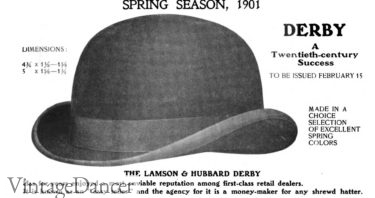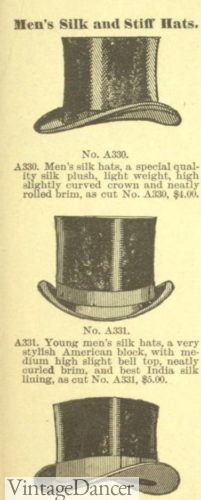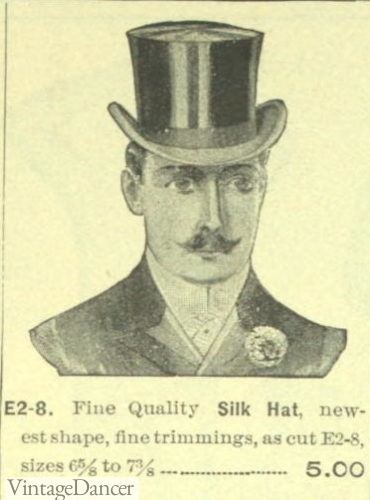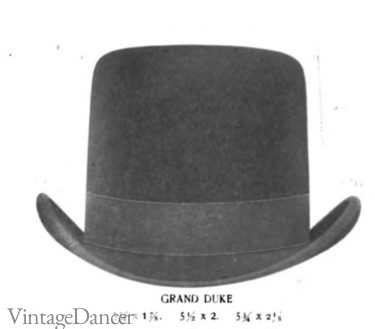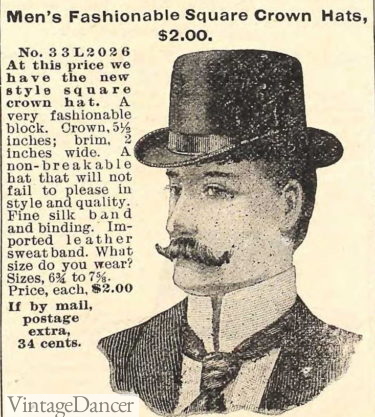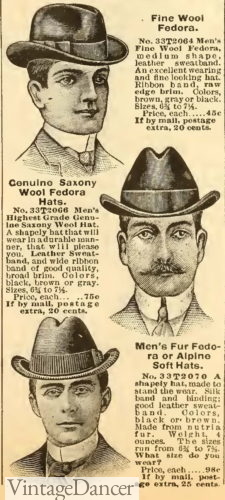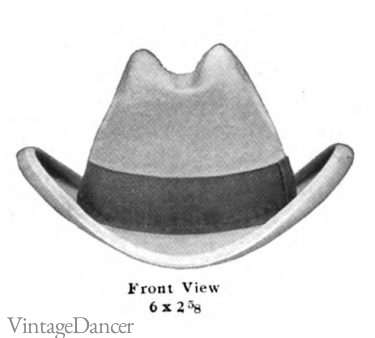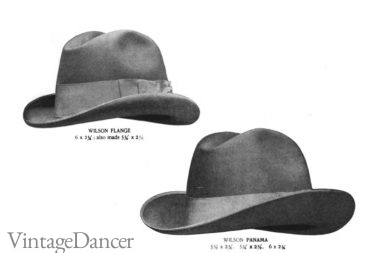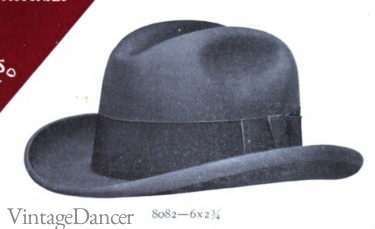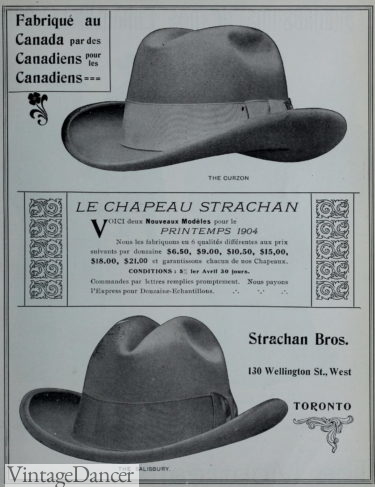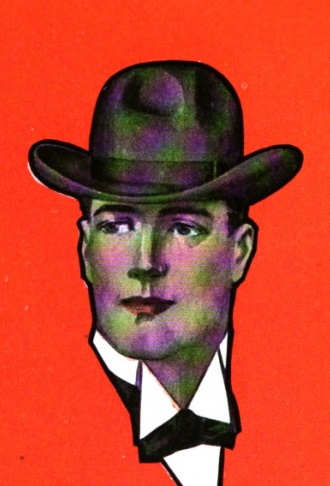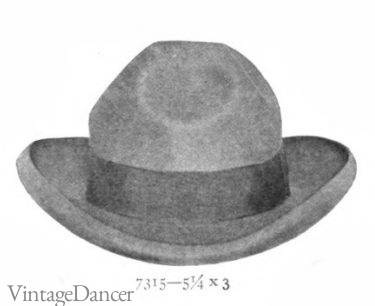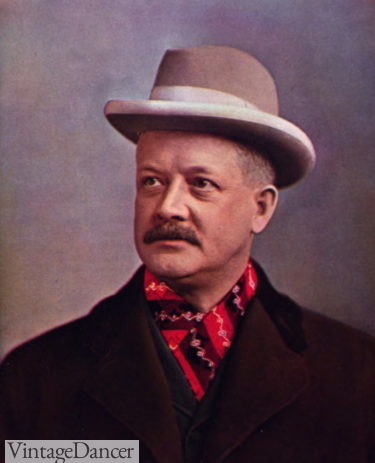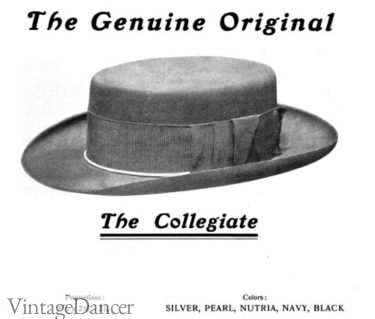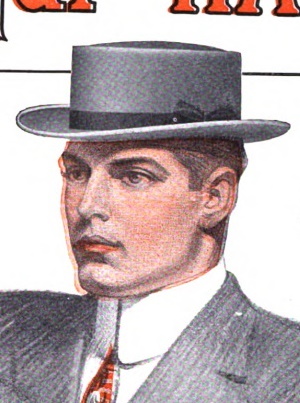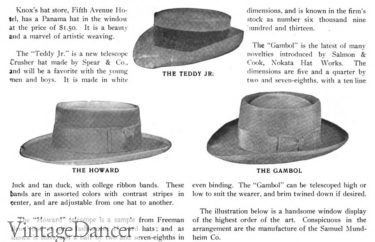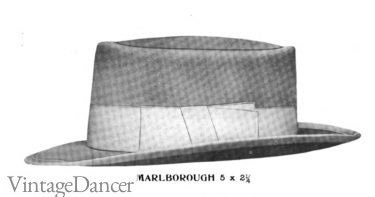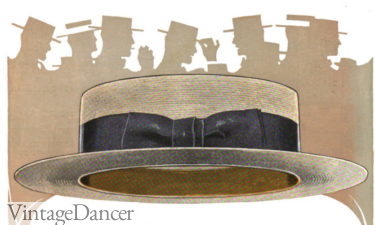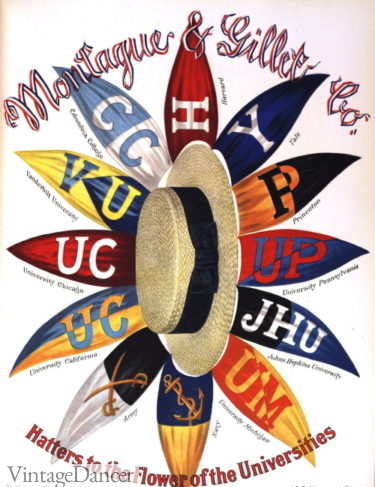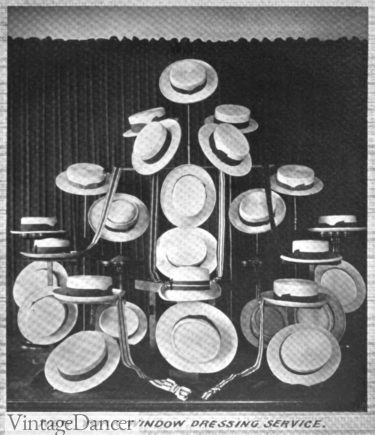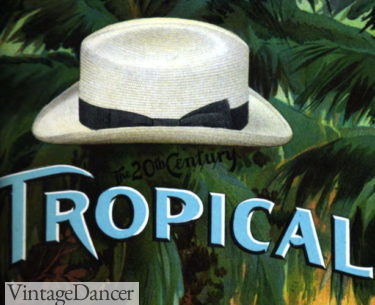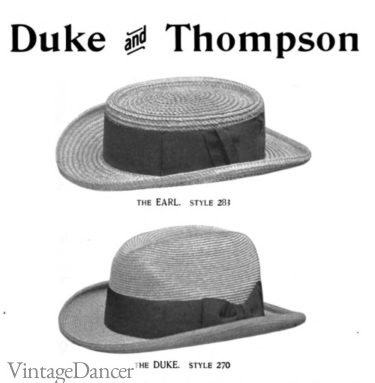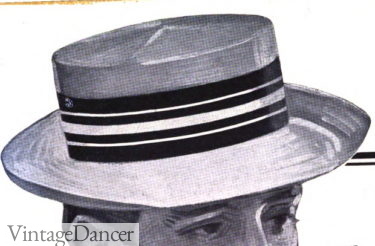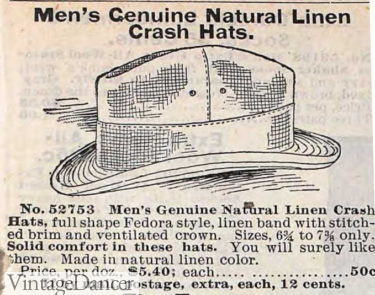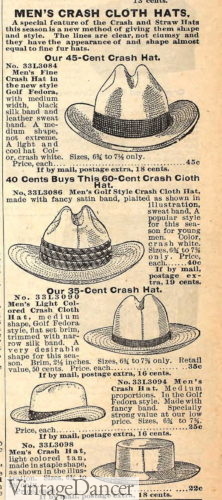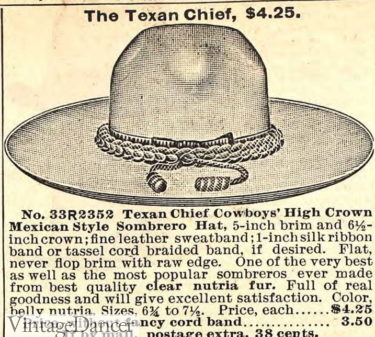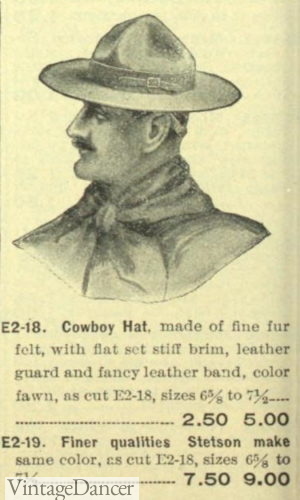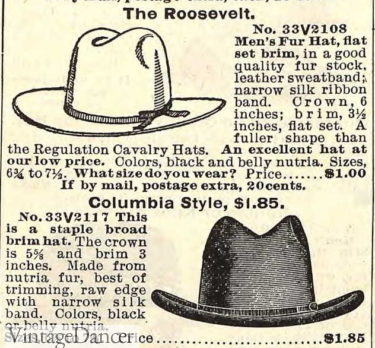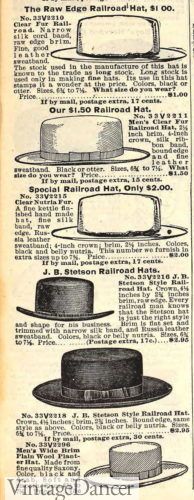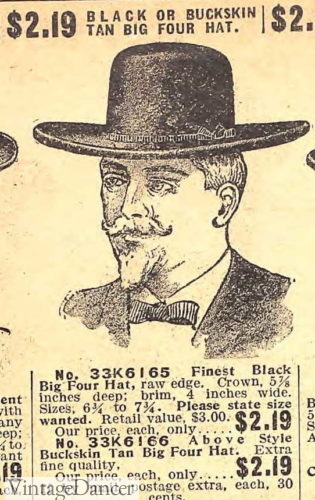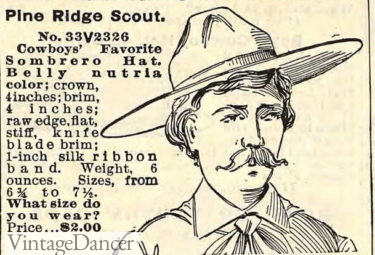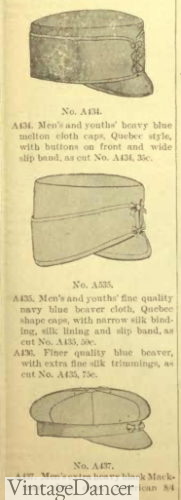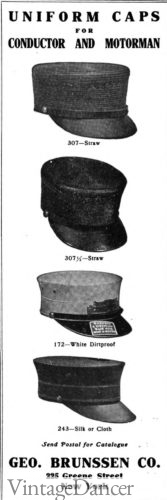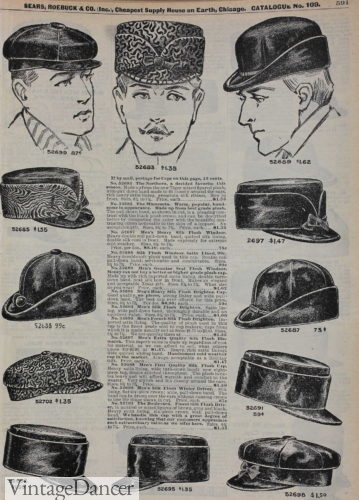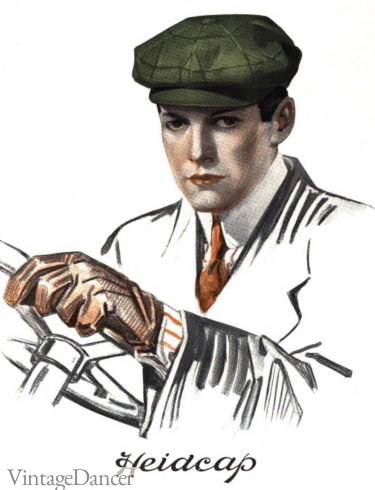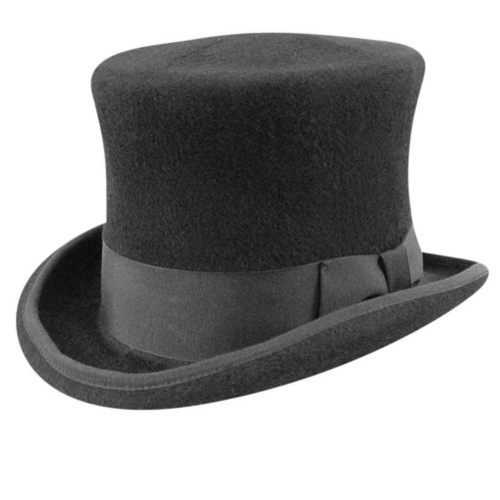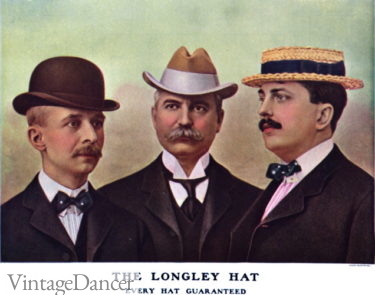
1900 men’s hats
In the 1900s men wore hats.. all… the… time. It was improper to be seen without a hat on outside. There were lengthy articles and discussions about appropriate hat shapes and colors for each class but ultimately the best hat was always the one that suited the wearer’s face. Young men favored smaller hats perched higher on the head with small brims while older men looked best in wider brim hats, taller crowns, and darker colors. Every town had a haberdasher shop where a hat was shaped to the wearer’s liking.
Men’s Edwardian era hat styles had a great variety with new shapes and colors coming out every season. Unlike the Victorian age with limited choices, the Edwardian man looked to his hat to define his character and compliment his outfit. Of the most common styles were the Debry hat, fedora, straw hat, top hat, western hat and golf cap. These and others are illustrated in this article.
Skip the history and buy an Edwardian era style men’s hats here.
Derby Hats
Of all the hat styles the Derby hat (bowler hat) was the most popular. They looked proper with a high white collar and tailored suit. The typical derby was 5 1/2 inches tall. Young men liked a 2 inch “dash brim” called a nobby Derby that dipped in the back and front. Mature men favored the 2 1/2 inch rolled brim Derby without a dip. Black fur felt with a black grosgrain silk hat band was almost the only choice to wear, with a few options in brown for spring and autumn.
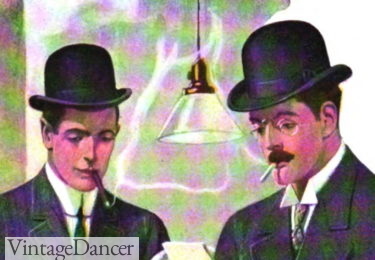
1907 two derby hats
- 1901 low crown derby hat
- 1907 classic derby hat
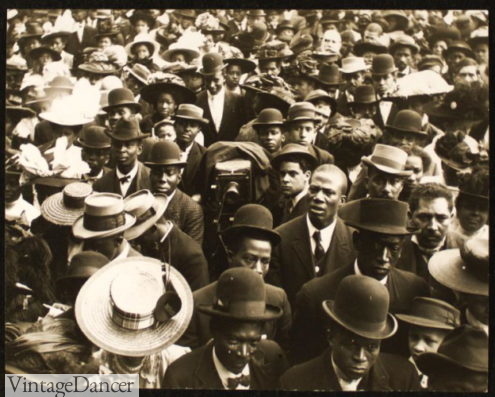
1910 a mix of derby hats, fedoras, telescope, boaters, square tops
Top Hats
The black silk top hat had long been a staple in men’s formal daywear and evening attire. The trend for men to wear top hat with day suits was beginning to fade in favor of derby hats and other stiff felt styles.
In the evenings however, a man must wear a black silk top hat with a tall crown (a little shorter for young men) with wide silk or vicuna hat band. The shape of the crown flared a bit at the top with a curled two inch brim. Despite the sameness that came with a traditional top hat men could experiment with tall or shorter heights, wider brims, tight rolls or small upturned brims. They also tried tilted or straight on placements. Like most hats of this era, they were worn perched on top of the head, barley coming down the forehead.

1910 – a Stag party with men in top hats
- 1900 Top Hats
- 1905 silk top hats
A similar hat to the top hat was called a square crown hat. It was made of stiff felt with a silk or leather hat band. Brim width was around 2 inches with rolled sides and a tall 5 1/2 inch crown. These were most fashionable for young men to wear during the day in business dress. The did not replaced the silk top hat for evenings.
- 1901 square crown hat
- 1901 square crown hat
Fedora Hats
It usually surprised people to learn the Fedora hat was worn back in the Edwardian era. It didn’t look exactly like the later styles of the 1920s-1950s, but the overall style notes were the same.
Fedora hats were semi-stiff fur felt hats with a center dent, side indentations, and a rolled brim. The “peaks” the denting formed are what gave early Fedoras the name Alpine hats. The pointed shape went away rather quickly but the more evenly balanced center sent fedora remained steady.
- 1902 Fedora and Alpine hats
- 1903 Alpine Fedora Hat
The Fedora’s brim was often rolled higher and the crown shorter for the young man. More variations of brown, chocolate, black, amber, tan and pearl added new colors to the sea of mostly black and dark brown hats. Silk hat bands matched the hat color of were a shade lighter. They could be a narrow 1/2 inch strip or very wide 2 1/12 inch ribbon with bow.
Most fedora hats were stiff fur felt but casual fedora hats were softer felts. These were more comfortable and easier to travel in. Soft fedoras were also called Tourist hats.
- 1901 fedora hats
- 1907 “Tourist” fedora
- 1902 Soft felt hats
- 1903 fedora hats
One other kind of generic fedora had four indentations around a tall crown but no center dent. It looked like it has a pinched crown. Its was a soft felt that could be crushed, folded, and sat on yet still pop back into shape. It was sometimes called a Crusher Hat although that term applied to any soft felt casual hat.
- 1905 crushable fedora hat
- 1905 crusher hat
Homburg Hats?
The stiff homburg hat was called a fedora in the 1900s. It had the same center dent that the Alpine and fedora had but lacked the side indentations. It was clean, smooth and conservative- an excellent hat for mature business men.
Telescope Crown Hats
Those sharp young college kids were always setting new trends in headwear. The oval crown “slouch hat” became known as the “Collegiate” hat after 1905. The crown could either have a flat top or an indented circle within the top (like a porkpie hat.)
These oval hats were also called Telescope crown hats. The sides could be arranged with a mild roll all around or flat “pan” shape with a slight upturn at the back. The one sided upturn became trendy towards 1910, sometimes referred to as the French style.
Like the fedora they came in many more shades, fitting the interests of fashionable dressed young men. Silver, pearl, nutria, navy blue, black, faun (tan), and even green.
- 1905 Collegiate Hat
- 1910 a handsome oval crown hat
- 1906 several telescope crown hats
- 1907 telescope hat
Boater Hats
In the summer men turned away from warm felt hats and wore straw hats and cloth hats instead. The most common straw hat was an oval crown “boater hat.” These stiff woven straw hat had colorful striped hat bands, often coordinating with a college, club or team sport colors. The height of the crown was short with a wide hat band and bow.
- 1908 plain boater hat
- 1910 striped boater hat
- 1909 hat bands for college teams
- 1907 boater hat display
Other Straw Hats
There were many more straw hats besides the classic boater. The telescope crown hat was a natural fit for straws. The panama hat (Optimo) as well as fedora shapes were also popular. Most straws were woven from very fine, light weight and light colored straws with dark hat bands. Straw hats were worn from mid may to Labor Day hat in both day and evening dress (except formal evenings attire.)
- 1901 fedora style panama hat
- 1900 boater and fedora style straw hats
- 1907 telescope crown straw hat with stripes band
- 1910 oval flat crown straw hat with stripes band
Cloth Hats
Straw hats were cool but fragile. A cloth hat was much more durable, although less classy. They were made into the same designs as soft felt hats and even boater hats. One name for a casual cloth hat was the “Crash” hat- it looked like a white fedora with a colorful patterned hat band such as plaid, checks, and polka dots.
- 1900 Linen “Crush” hat
- 1901 cloth hats
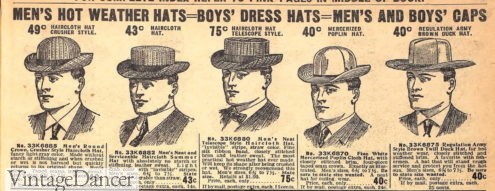
1908 summer cloth hats
Western Hats
Up to this point the hats we have seen have been for gentlemen, college men, and business class men. There was a wide range of other hat styles oriented to the Western man, the rancher, and farmer or those who resided near those areas. Westerns hats were made up in felts and straws with a very wide 5 1/2 inch brim.
Felt hats were either black or buckskin tan. They were not necessarily only for the working classes. President Roosevelt was found of a wide brim cowboy hat with center dent.
These hat styles need their own article because the variety was far greater than gentlemen’s hat styles. Each hat style had an associate occupation or region and their names reflected these: Sombrero, pasha, cow puncher, Montana, Cuban, Columbia, Pine Ridge Crest, Phoenix, Texan, Calvary, cowboy, Governor, The Big Four, railroad, Idaho and many more. Here are some of them:
- 1902 Texan Chief hat
- 1905 Cowboy hat
- Roosevelt hat and Columbia hat 1903
- 1903 Railroad hats
- The Big Four hat 1908
- Pine Ridge Scout hat 1903
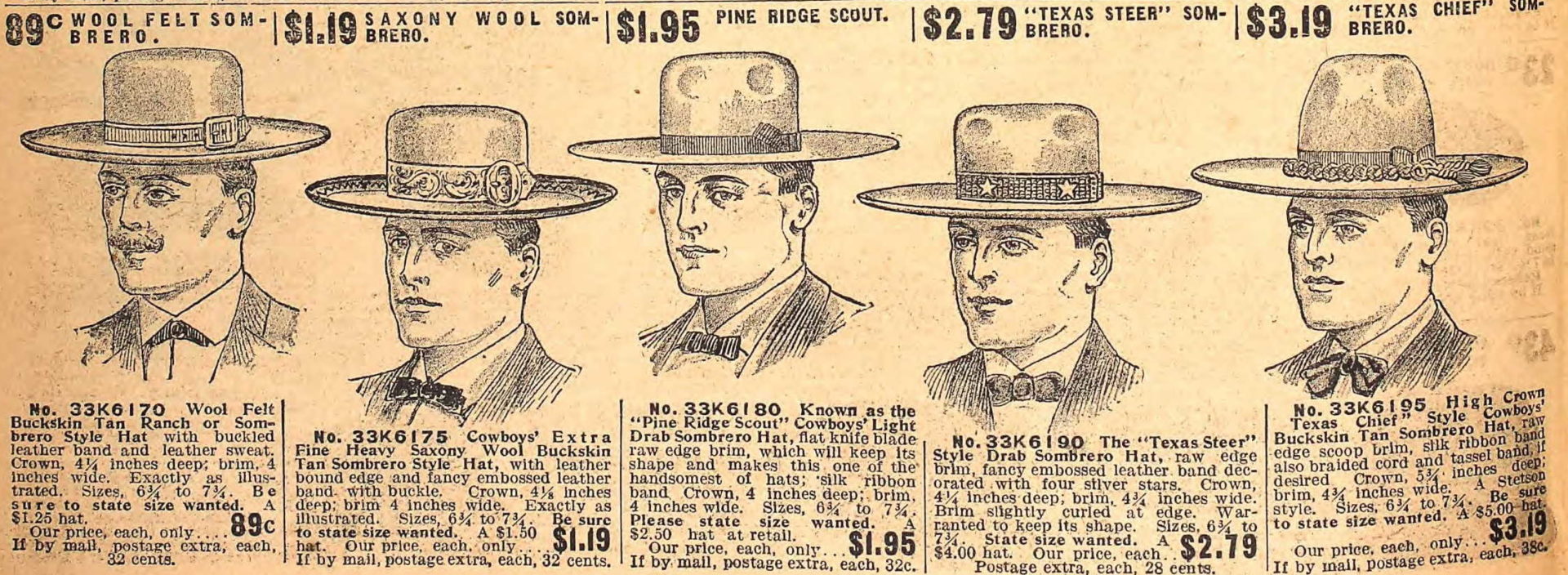
1908 Sombrero hats with western buckles, stars and braiding.
Work and Winter Caps
While western hats were for men who worked outdoors on farms and ranches, caps were worn by city folk. There were many different styles and names for small stiff visor caps with or without fold down ear flaps and neck guards. Some caps were worn with uniforms such as the Chauffeurs cap, railroad conductor, or captain Yachting cap. Most caps were generic for all kinds of working class occupations as well as outdoor sports (hunting, hiking.)
Some common caps were Quebec (laced in front), Brighton cap (similar to Quebec- no laces or faux bows), Engineers cap (Train work), Storm cap, Judge, Havelock, Detroit, Hunters, and Bismarck. Materials were sturdy wool, corduroy and even straw. In Winter fur lining or all fur caps kept heads and ears very warm.
More about men’s working class clothing.
- 1900 Quebec cap
- 1907 Uniform caps- Yacht, Chauffer, Engineer
- 1900 fur winter caps
- 1901 all styles of caps
Golf Caps
The one working class man’s hat to cross into upper-class territory was the English golf cap or driver cap. Sewn from 6-8 triangles with a soft body and stiff brim it goes by other names today such as Newsboy, flat cap, big apple. They were often made of tweed, cashmere, cotton broadcloth, or a patterned wool (stripes, plaid, checks) but could also be corduroy or leather for the driving style.
Working classes wore these affordable caps daily while upper classes wore them only for sports such as golf and driving cars. Some daring college kids mixed them with their suits, a new and increasingly trendy way to dress.
- 1900 golf caps
- 1909 green windowpane check cap
1900s Style Men’s Hats
Men worn their hats for at least 2 years or whenever they were too worn out to keep cleaning and reshaping. Straw hats lasted only a summer season (or half a season.) For this reason surviving hats are rare and very expensive.
There are very few companies making reproduction men’s hats but some classic shapes that are still available can work for this era. These are some we like: New Edwardian Style Men’s Hats 1900-1920
